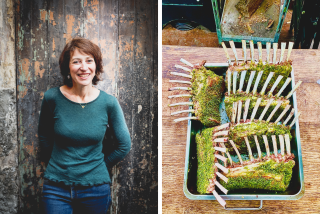Tributes to an American âFrench Chefâ Who Wished the World âBon Appetitâ
The average luminary appears on TV, gets medals, writes an autobiography. But it takes someone really special to become the subject of an exhibition in her own lifetime. This year, not one but three museums--two in Washington, D.C., and one in Napa Valley--have focused attention on Julia Child, a Pasadena native who turned 90 last month and now lives near Santa Barbara. These exhibitions give us an opportunity to better know the woman who raised a glass of wine to the world and wished it bon appetit.
I had the good fortune to lunch with her earlier this year in Santa Barbara, where she is often seen at the farmers market and in restaurants such as Esauâs Coffee Shop on State Street. At the Four Seasons Biltmore, the concierge provides guests with computer-generated directions to La Super-Rica Taqueria, a nearby Mexican restaurant thatâs one of Childâs favorites.
She wears her fame with a touch of wryness. âI can usually get a table at a restaurant,â she said. When she was asked to donate the kitchen from her Cambridge, Mass., home to the Smithsonianâs National Museum of American History in Washington, D.C., Child hesitated. Rayna Green, one of the curators, told me she had to persuade Child that the kitchen exhibit would have importance beyond Child herself and the cult of personality that surrounds her.
Green, who eventually won Child over, thinks the exhibition highlights the role of the kitchen in American family life and its evolution from the â50s on, as demonstrated by such reliable retro implements as Childâs old Ekco vegetable peeler. âItâs a representative American kitchen,â Green said. âMost Americans think theyâve been there.â
Green helped dismantle the domestic and spiritual heart of the Cambridge home where Child lived for four decades with her husband, Paul, who died in 1994.
Her Norwegian pine table, the Garland industrial range and her trusty KitchenAid mixer are in the reassembled kitchen at the National Museum of American History. I toured it late last year and was struck by the absence of high-tech gadgets. Green said Child preferred her old toaster oven to a microwave (though she was quick to embrace the Cuisinart). When I mentioned to Child that the kitchen seemed far from state-of-the-art, she said, âIt was state-of-my-art, a working kitchen.â
In a few respects, however, the museumâs Child kitchen isnât fully intact. She gave the house to Smith College, her Northampton, Mass., alma mater, and her cookbooks and papers to the Schlesinger Library at Radcliffe. Her copper pans went to Copia: The American Center for Wine, Food and the Arts, which opened last year in Napa and has a restaurant called Julia.
The famous pans, on permanent display in Copiaâs entrance hall, were purchased in the â40s and â50s when the Childs lived in France, and they are lined with tin, which âThe French Chefâ preferred to stainless steel.
Of course, she also likes France and the French. âThey are prickly but fun,â she said. âIf youâre delighted to be there, they open up like flowers.â
In 1948, Paul went to work for the U.S. Information Service in Paris, and she took up studies at the Cordon Bleu cooking school in a class full of ex-GIs, conducted in French. Child, who is more than 6 feet tall, wasnât intimidated. âBeing tall, like I am, I never felt inferior,â she said.
But her career didnât get started until around 1960, when âMastering the Art of French Cooking,â which she co-wrote with Simone Beck and Louisette Bertholle, was published and pilots for her first cooking show, âThe French Chef,â were filmed.
She didnât set out to become Americaâs cooking teacher. In college, she thought she would be a secretary or nurse.
During World War II, Child was a clerk for the Office of Strategic Services (or OSS, a precursor of the CIA) in Sri Lanka (then Ceylon) and China. She flew over the Himalayas as coolly and collectedly as if on the train from Boston to New York, her former OSS colleague Betty McIntosh recalled in an interview. In the OSS, she met her future husband and handled sensitive documents, though she wasnât a spy.
Child, along with other Mata Haris, is featured in a display through December at the Women in Military Service for America Memorial at Arlington National Cemetery near Washington, D.C. The exhibit is called âClandestine Women: The Untold Stories of Women in Espionage.â
âJulia was a bright person, good at her job, and she always had a light touch,â McIntosh said.
The silly code names given to secret agents annoyed Child. She once wrote to OSS headquarters requesting âone of those books you have giving people numbers and funny names, like âFruitcake No. 385.â Frequently we find references to them here and no one knows who on Earth is being referred to,â she is quoted as saying in âAppetite for Life: The Biography of Julia Child,â by Noel Riley Fitch (Anchor, 1997).
Funny, smart and as practical as a pan--thatâs the Julia Child you get to know through these exhibits. And the more you know her, the more you like her, completely apart from souffles and puff pastry.
National Museum of American History, 12th Street and Constitution Avenue N.W., Washington, DC 20560; (202) 357-2700, www.americanhistory.si.edu.
Copia, 500 1st St., Napa, CA 94559; (707) 259-1600, www.copia.org.
The Women in Military Service for America Memorial, (800) 222-2294 or (703) 533-1155, www.womensmemorial.org, at the ceremonial entrance to Arlington National Cemetery, Arlington, Va.
More to Read
The biggest entertainment stories
Get our big stories about Hollywood, film, television, music, arts, culture and more right in your inbox as soon as they publish.
You may occasionally receive promotional content from the Los Angeles Times.










